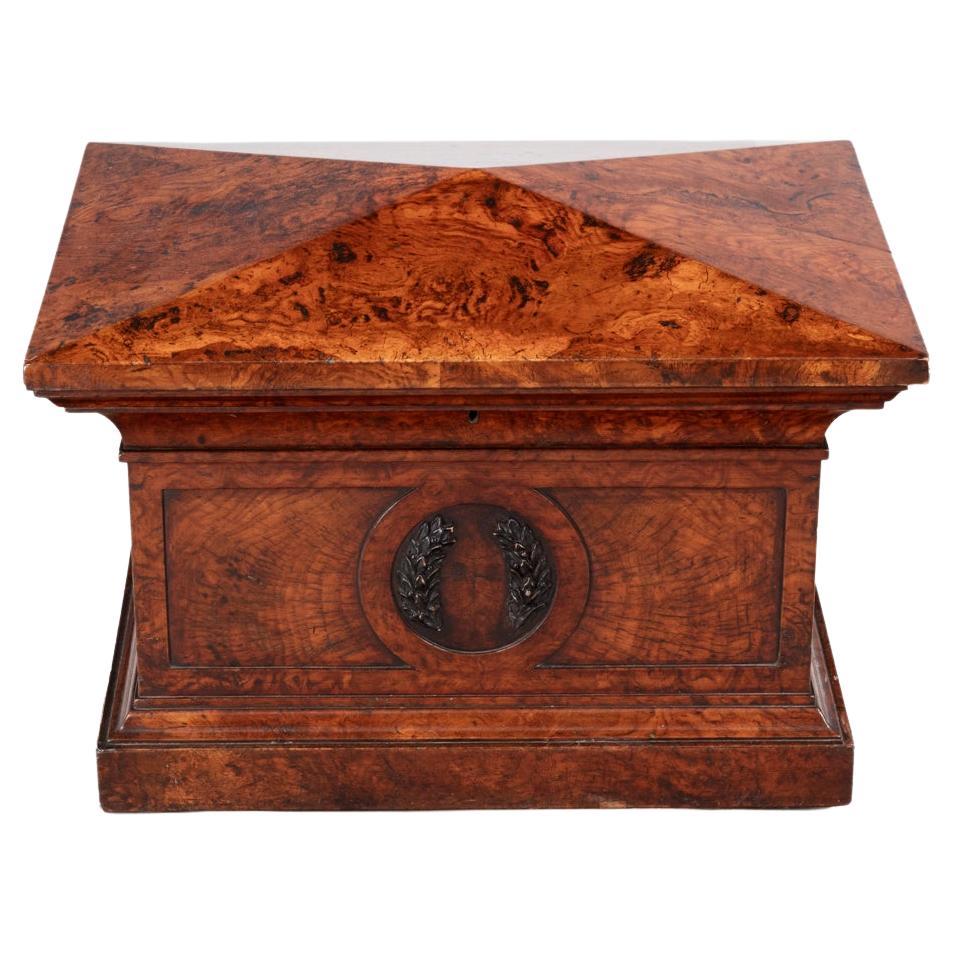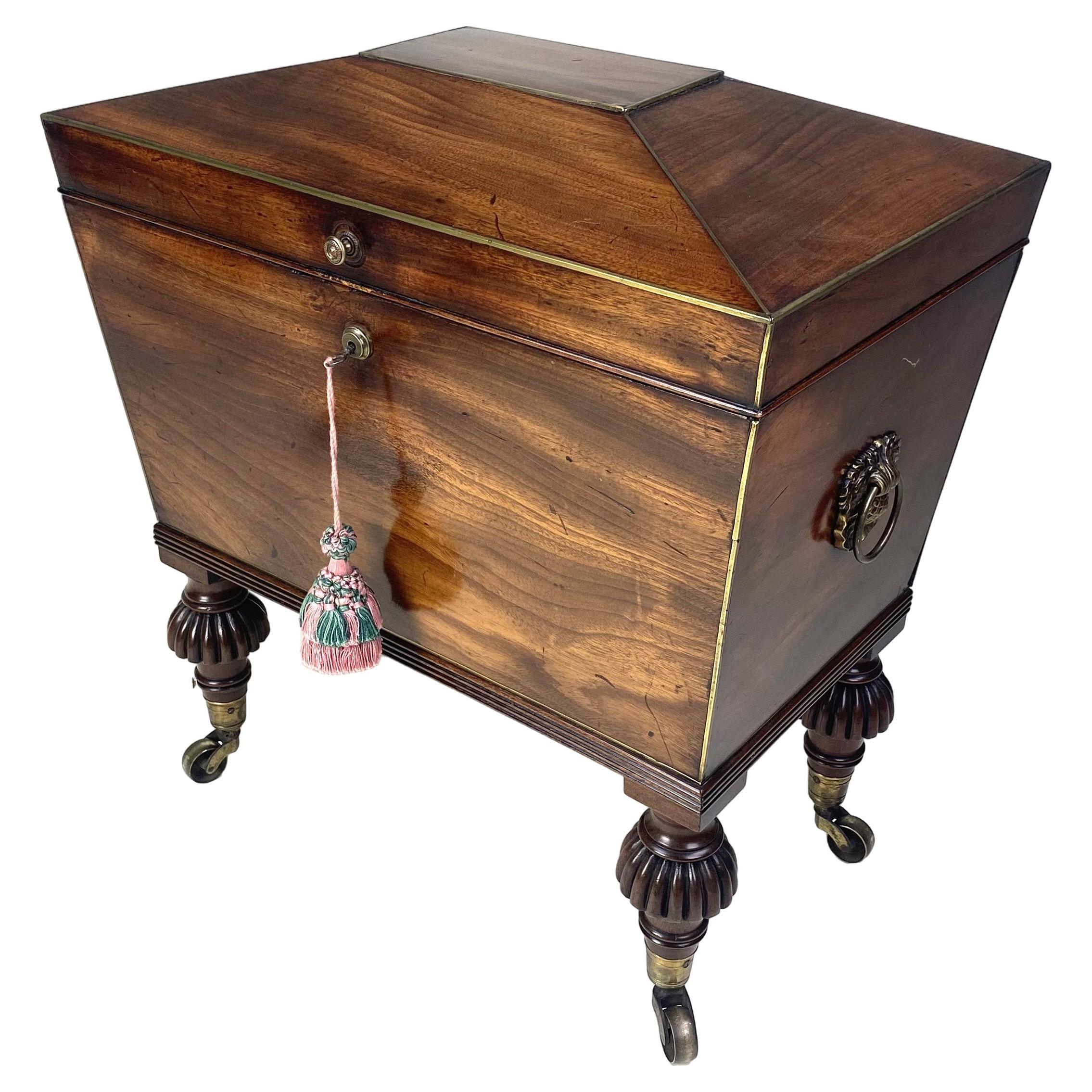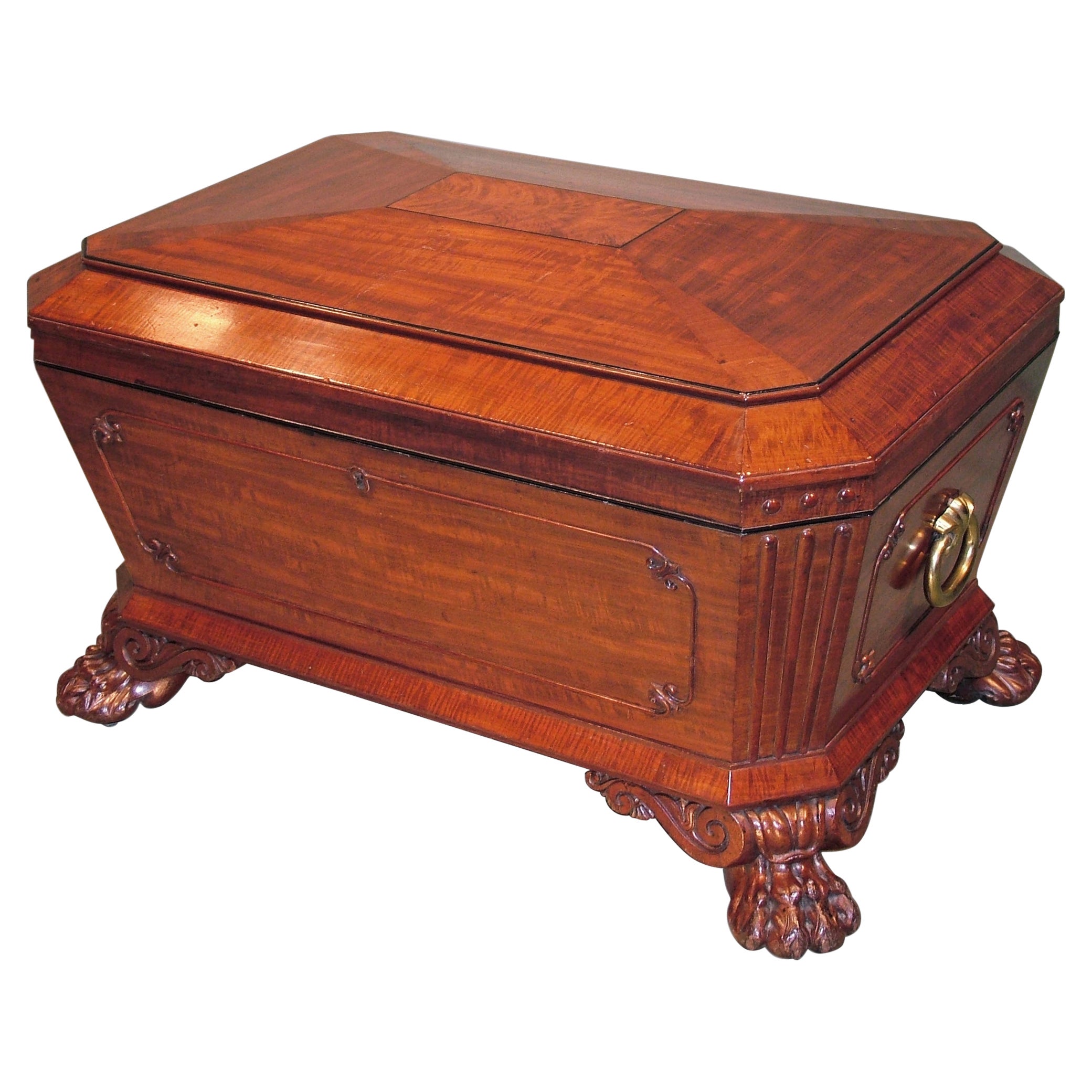Items Similar to Regency Pollard Oak Sarcophagus Shaped Cellarette
Want more images or videos?
Request additional images or videos from the seller
1 of 10
Regency Pollard Oak Sarcophagus Shaped Cellarette
About the Item
Captivating English late Regency period pollard oak cellarette - wine cooler of substantial proportions having the most enchanted untouched color and patina ‘skin’.
English - George IV, circa 1825.
A wonderful object, almost art like for the collector…. The best chosen pollard oak veneers, having been waxed for almost 200 hundred years have obtained an enthralling color and patination.
Of sarcophagus form, the shaped flattened pyramidal top with beaded and moulded edge above panelled sides with conforming beading, raised on stepped square feet over a moulded platform with concealed castors.
A strong Regency design inspired by Greco-Roman models. There was a tendency at this period to celebrate native timbers as a gesture of patriotism during the Napoleonic wars, and one of the more exotic examples was burr or pollarded oak which found favour amongst famous designers of the Regency period such as the likes of George Bullock.
Measures: Width 33 inches 84cm
Height 21 1/4 inches 54cm
Depth 23 1/2 inches 60cm.
- Dimensions:Height: 21.26 in (54 cm)Width: 33.08 in (84 cm)Depth: 23.63 in (60 cm)
- Style:Regency (Of the Period)
- Materials and Techniques:
- Place of Origin:
- Period:
- Date of Manufacture:circa 1825
- Condition:Wear consistent with age and use. A wonderful object, almost art like for the collector…. The best chosen pollard oak veneers, having been waxed for almost 200 hundred years have obtained an enthralling colour and patination.
- Seller Location:Benington, GB
- Reference Number:
About the Seller
5.0
Gold Seller
These expertly vetted sellers are highly rated and consistently exceed customer expectations.
Established in 1969
1stDibs seller since 2015
112 sales on 1stDibs
Typical response time: <1 hour
Associations
LAPADA - The Association of Arts & Antiques DealersThe British Antique Dealers' Association
- ShippingRetrieving quote...Ships From: Benington, United Kingdom
- Return PolicyA return for this item may be initiated within 3 days of delivery.
More From This SellerView All
- Extremely Rare Pair of Regency Cast-Iron Sarcophagus Shaped Strong BoxesLocated in Benington, HertsAn extremely rare pair of Regency cast-iron sarcophagus shaped strong boxes. Regency, circa 1820 Painted to simulate palisander wood and with parcel-gilt, the cavetto-moulded hinged lids cast with flower sprays above foliate-cast bands over front panels relieved with river gods within canted corners cast with standing muses, the sides with lion mask and ring handles over leafy aprons on massive lion’s paw feet; the Brahmah type lock stamped “T. Davis from London” and impressed with the Royal Crown. These extraordinary pieces are modelled on Regency wine coolers. The forms are classic Greco-Roman revival with the boat-hook handles, mythic figures and the overall sarcophagus pattern. You would struggle to find one let alone a pair. Good items for any collection. Research on going into these strong boxes but we have found possible information on the lock stamped Davis….(historyoflocks ) The relationship of King George III and George Davis of Windsor, who was locksmith in ordinary to His Majesty. Davis, in 1799, invented and patented a unique style of lock, which was also beautifully engraved with a warning not to make duplicate keys. Sensitive government secrets always demanded, then as today, locks that were state of the art. Davis locks ended up on government dispatch boxes...Category
Antique Early 19th Century English Regency Commodes and Chests of Drawers
MaterialsIron
- Exceptional Quality Pollard Oak Mid-19th Century SideboardLocated in Benington, HertsAn exceptional quality and rare pollard oak 19th century architectural twin pedestal inverted breakfront sideboard. English, circa 1850. The quarter cut inverted breakfront top...Category
Antique Mid-19th Century English Victorian Sideboards
MaterialsOak, Burl
- Fine Regency Amboyna And Ebony Inlaid Gilt Bronze Mounted Shaped CabinetLocated in Benington, HertsOf outstanding quality, an early 19th Century Regency ormolu mounted amboyna and ebony shaped side cabinet on tapering legs English circa 1810. Finely decorated with ebony bea...Category
Antique 19th Century English Regency Cabinets
MaterialsEbony, Amboyna
- Regency Amboyna and Brass Inlaid Gilt Bronze Mounted Pier TableLocated in Benington, HertsAn extremely elegant, rare Regency amboyna and brass inlaid gilt bronze mounted pier table. Provenance Part of Sir William Whitfield Collection. English Regency period, Circa 1815. The raised back with open shelf, surmounted by a pierced anthemion three quarter brass gallery above a rectangular mirror plate, flanked by gilt bronze pierced foliate scrolled supports, over a finely coloured amboyna and banded top above cut brass inlaid frieze drawer decorated with anthemion and flower head motif. The dual tapering scroll supports with palmette lappet surmounts and cut brass inlay terminate on gilt bronze claw feet, flanking a later large mirror plate to the rear, raised on a inverted breakfront plinth base edged with gilt bonze beading. Formerly in the collection of Sir William Whitfield. This elegant Regency pier table is a superb example with its fine quality mounts and distinctive amboyna veneers which are rarely found on furniture of this period. The condition is excellent, having the most wonderful colour and patination to the finest cuts of amboyna that would have been available, during the early 19th century this veneer was thought to be worth more in its weight than gold. This table would have almost certainly been especially commissioned, further research maybe undertaken to find a comparative example and insight to a potential maker. As such pieces in amboyna are far rarer, an example of pier table has yet to be found, but an amboyna sofa table with extremely similar brass inlay and form can be seen in Clifford Musgrave’s book Regency Furniture, published by Faber and Faber in 1961, plate 63. It is from the Royal Collection and the caption includes ‘made about 1816 for Clarement,’ (Claremont) ‘ Esher, Surrey, home of the Princess Charlotte...Category
Antique 19th Century British Regency Vanities
MaterialsBrass, Bronze
- Important Regency Mahogany Partners Writing Table in the Manner of George SmithBy Charles Norman, George SmithLocated in Benington, HertsA highly Important, Early Regency period mahogany, ebonised and parcel-gilt partners writing table on monopodia legs of exceptional quality and design, in the manner of George Smith, stamped Chas Norman, whom was associated with the work of Gillows. Labelled ‘Morning Room’. English, Regency period, circa 1810. Rarely seen, the crescent shaped ended rectangular top, beautifully lined with the original gilt tooled leather writing surface, enclosed by a mahogany cross-banded border and reeded edge. The frieze, containing four finely chosen fiddle-back mahogany drawers, two pairs to opposing sides, each retaining the original gadrooned carved ebonised knob handles. The perimeters having a finely ebonised cockbead, whilst the drawer liners being executed in mahogany retain the original recessed brass locks, which look to have never been removed. Flanking the drawers are bead-moulded ebonised panels which conform to either end above a reeded mould. Raised on four boldly designed and imposing, crisply carved, ebonised and parcel-gilt leopard monopodia supports, of wonderful original waxed condition. The Egyptian leopards mask above a bold breast decorated with carved gilt anthemion and guilloche motifs, finishing on a finely detailed carved leg and paw foot. The condition is excellent, retaining the original hand-dyed and gilt tooled waxed leather writing surface along with original locks, handles and ebonising with gilt-work to the legs. Commissioned for what presumes to be a private collection and due to its condition, being obvious to see, this writing table has been home to an important household. Labelled ‘Morning Library’ to the underside, whilst in this exemplary condition strongly suggests this striking piece of Regency furniture has furnished the library of the said house for the majority of its life. As can be noted, this is an extremely rare, elegant, early Regency writing table of exceptional colour, which corresponds with designs of the celebrated furniture maker and designer George Smith, workmanship of Gillows, being stamped to the underside Chas Norman four times. George Smith (1756 - 1826) was one of the most influential furniture designers of the English Regency Period (1811-1830). Smith, who began his pattern-book in 1804, wrote of ‘the great taste and elegance’ of this design. In 1808 he published his influential and definitive text on Regency interior Design titled ‘ A Collection of Designs for Household Furniture and Interior Decoration’ and classed himself as ‘Upholder Extraordinary to His Royal Excellency the Prince of Wales’…The Prince Regent. Smith was inspired in his designs from his earlier career as an Egyptologist, producing drawings incorporating motifs of Leopards heads and paws, Lions, sphinx’s, anthemia, and griffons amongst others. Charles Heathcote Tatham (1772-1842) published ‘Etchings, Representing the Best Examples of Ancient Ornamental Architecture; Drawn from the Originals in Rome, and Other Parts of Italy During the Years 1794, 1795, and 1796’, in which he illustrated an antique tripod table...Category
Antique 1810s British Regency Desks and Writing Tables
MaterialsMahogany, Giltwood
- Victorian Bleached Oak DresserLocated in Benington, HertsA good quality Victorian bleached oak dresser standing on carved cabriole legs. This well proportioned dresser having a moulded cornice over a shelved upper section with grooved plate troughs and two lockable cupboard doors with brass escutcheon plate drop handles. The upper section sitting over a deeper base with two moulded oak lined drawers with hand-cut dovetails to the right-hand side and with the left-hand having a fielded and paneled door. The whole being raised on carved cabriole legs with acanthus leaf to the knee terminating on ball and claw feet. In excellent condition with no loose joints this Victorian oak dresser...Category
Antique 19th Century English Victorian Dressers
MaterialsOak
You May Also Like
- 19th Century Late Regency Pollard Oak Sarcophagus Form CellaretteBy Thomas Wilkinson & SonsLocated in Dublin 8, IE19th Century late Regency pollard oak sarcophagus form cellarette stamped Wilkinsons & Sons, 14 Ludgate Hill, the hinged lid enclosing a six division lined interior with brass ratche...Category
Antique 19th Century Irish Regency Wine Coolers
MaterialsOak
- Small Regency mahogany sarcophagus shaped CellaretteBy Gillows of Lancaster & LondonLocated in Folkestone, GBA fine qualioty Regency period mahogany celleate of small size with brass line inlaid edges and raised on turned and reeded inverted vase-shaped legs and fitted with original ring ca...Category
Antique Early 19th Century English Regency Wine Coolers
MaterialsMahogany
- 19th Century English Regency Sarcophagus-Form Cellarette in MahoganyLocated in Atlanta, GARegency mahogany cellarette with sarcophagus-form, paw feet, and lion's head handles, 19th Century, England.Category
Antique 19th Century English Regency Wine Coolers
MaterialsMahogany
- English Regency Mahogany Sarcophagus Shaped Wine CoolerLocated in Bedfordshire, GBA fine quality regency perioid mahogany sarcophagus shaped wine cooler, or cellarette, retaining original brass carrying handles and fine colour throughout, raised on original plinth...Category
Antique Early 19th Century English Regency Wine Coolers
MaterialsMahogany
- 19th Century Regency Mahogany Sarcophagus-Shaped Wine CoolerLocated in London, GBA fine early 19th century Regency period fiddle back mahogany and ebony strung sarcophagus shaped wine cooler, having centre panelled mitered top above beaded canted corner panelled ...Category
Antique 19th Century English Regency Wine Coolers
MaterialsMahogany
- Regency Mahogany CellaretteLocated in New Orleans, LAThis refined Regency-period wine cellarette is crafted of rich mahogany and boasts beautifully carved details. The sarcophagus form is distinguished by ebon...Category
Antique Early 19th Century English Regency Wine Coolers
MaterialsBrass, Lead





